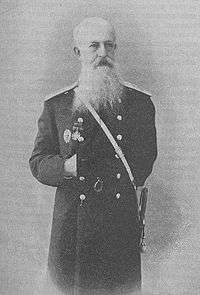Alexandr von Bilderling
| Alexandr von Bilderling | |
|---|---|
|
Alexandr von Bilderling in 1899 | |
| Born |
5 July [O.S. 23 June] 1846 near Saint Petersburg, Russian Empire |
| Died |
26 July [O.S. 13 July] 1912 (aged 66) Pushkin, Saint Petersburg, Russian Empire |
| Allegiance |
|
| Service/branch | Imperial Russian Army |
| Years of service | 1866-1905 |
| Rank | General |
| Commands held |
17th European Army Corps Third Manchurian Army |
| Battles/wars |
Russo-Turkish War Russo-Japanese War |
Baron Alexandr Aleksandrovich von Bilderling (Russian: Александр Александрович Бильдерлинг) (5 July [O.S. 23 June] 1846 – 26 July [O.S. 13 July] 1912) was a general in the Imperial Russian Army, noted for this role in the Russo-Japanese War and an artist and monument designer.
Biography
Bilderling was from the German-Baltic nobility in Courland; his father was a lieutenant-general in the Imperial Guard. He graduated with honors from the Page Corps and was commissioned as a cavalry lieutenant in 1864 and promoted to captain in 1866. He graduated from the General Staff Academy in 1870 and served in the Kiev Military District from 1870-1875. Promoted to colonel in 1872, he became commandant of the Tver Cavalry Academy in 1875 and was assigned command of the 12th Dragoon Regiment in 1877 and became commandant of the prestigious Nikolaev Cavalry School in 1878.
From 1877-1878, Bilderling participated in the Russo-Turkish War. He joined the General Staff in 1891 and was promoted to lieutenant-general in 1892. In 1899, he became commander of the 17th Army Corps and was promoted to general of cavalry in 1901.
During the Russo-Japanese War of 1904-1905, Bilderling commanded the 17th European Army Corps from May 1904, accompanying it to Manchuria in the summer of the same year. He was in command of the eastern flank at the Battle of Liaoyang, and the western flank at the Battle of Shaho. After the Battle of Sandepu, Bilderling was replaced Alexander Kaulbars as commander of the Third Manchurian Army. However, after the Battle of Mukden, he was relieved of his command from May–September 1905, and was replaced as commander of the Third Manchurian Army by General Mikhail Batyanov. He was later bitterly blamed by General Aleksey Kuropatkin for the defeat. He served as a member of the Board of War from 1905-1913.[1]
In addition to his military career, Bilderling was also a painter of note, and designer of monuments. In his declining years, he participated in commissions for installing monuments and organizing commemorative activities.
He was buried at the Novodevichy Cemetery in Saint Petersburg, but his grave is not preserved.
Awards
.png) Order of St Vladimir 4th degree
Order of St Vladimir 4th degree.png) Order of St Vladimir 3rd degree
Order of St Vladimir 3rd degree.png) Order of St Vladimir 2nd degree
Order of St Vladimir 2nd degreeOrder of St. Anne 3rd degree
Order of St. Anne 2nd degree
Order of St. Anne 1st degree
Order of St. Stanislaus 3rd degree
Order of St. Stanislaus 2nd degree with swords
Order of St. Stanislaus 1st degree
 Order of St. Alexander Nevsky (1904)
Order of St. Alexander Nevsky (1904) Order of the Sword, 1st class (Sweden)
Order of the Sword, 1st class (Sweden) Order of the Crown, 2nd class (Prussia)
Order of the Crown, 2nd class (Prussia) Order of the Red Eagle, 1st class (Prussia)
Order of the Red Eagle, 1st class (Prussia) Legion of Honor, Commanders Cross, (France)
Legion of Honor, Commanders Cross, (France) Gold Sword for Bravery
Gold Sword for Bravery
References
- Connaughton, R. M. (1988). The War of the Rising Sun and the Tumbling Bear—A Military History of the Russo-Japanese War 1904–5. London. ISBN 0-415-00906-5.
- Jukes, Geoffry. The Russo-Japanese War 1904–1905. Osprey Essential Histories. (2002). ISBN 978-1-84176-446-7.
- Kowner, Rotem (2006). Historical Dictionary of the Russo-Japanese War. ISBN 0-8108-4927-5: The Scarecrow Press.
Notes
- ↑ Kowner, Rotem (2006). Historical Dictionary of the Russo-Japanese War. ISBN 0-8108-4927-5: The Scarecrow Press. page 72
